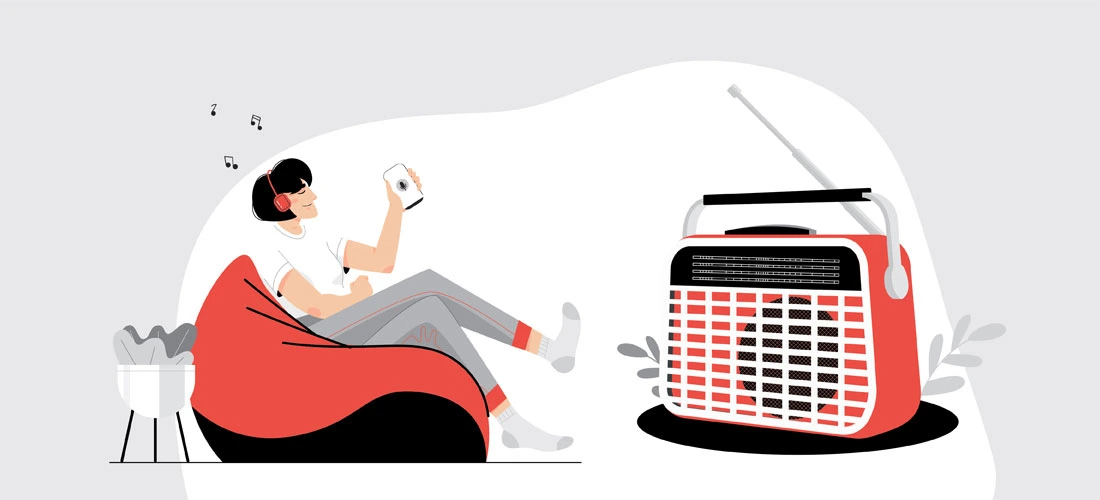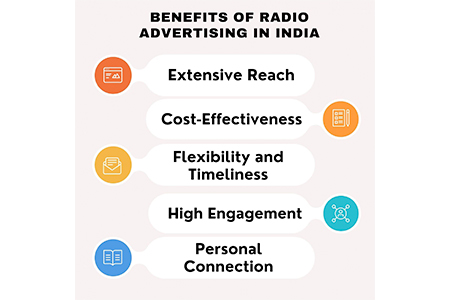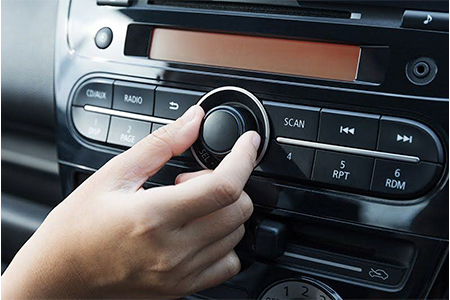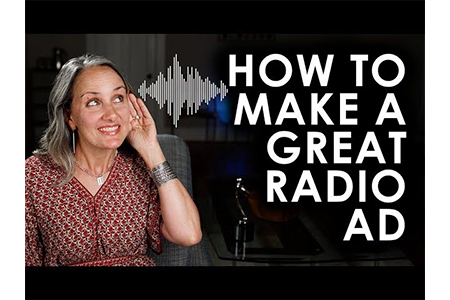Everything You Need To Know About Advertising On Radio

What is Radio Advertising
A radio advertisement is the promotion of products or services during radio commercials or programs. One of the most popular medium that people can connect to is this one. When promoting their goods and services, some advertisers opt for radio advertising, purchasing commercials, often known as spots in the radio industry. It is one of the best platforms to sell the services of various businesses because of its popularity. A memorable jingle and tagline will make it simple for listeners to recall the brand.
Wide Reach Across Diverse Audiences
Radio advertising can transcend social, cultural, and geographic boundaries. Brands can attract both urban and rural listeners, with millions of people tuning in every day. The advantage of radio ads is that they are accessible since they reach people at their homes, while commuting, and even at workplaces. The main advantage of radio advertising is this continuity, which keeps the brands in the memory of the listeners and audiences when serving the needs of various audiences in different regions.
Cost-Effective Advertising Solution
The ultimate benefit of radio advertising is its cheapness relative to television or print. The business can also afford to run powerful campaigns with flexible radio advertising rates. Given the fact that radio advertising yields a cost based on the time of day on which the ad is run and the length of the ad run, the brands can maximize their expenditure without affecting reach. This is what makes radio advertisements particularly worthwhile to local companies because it provides a relatively quantifiable payoff with marketing funds remaining well within reach.
High Frequency and Repetition for Better Recall
Radio advertising enables repetition of the ad several times during the day, unlike a one-time advertisement in print or on television, where the audience may fail to remember. Regular exposure promotes the message of the brand, bringing familiarity and credibility. Such repetition, a catchy jingle, or influential storytelling creates a high level of memorability. The examples of radio advertising in the world demonstrate that the ability to be consistent makes a difference. With the strategic placement of ads, the benefits of radio advertising become obvious, namely, brands remain appropriate and in the minds of their target audience.
Localized Targeting and Community Engagement
The special advantage of radio advertising is that it reaches out to localities with precision. Certain stations are specific to given geographies, languages, and interests of the listeners to enable brands to relate in a real manner. Be it the advertisement of a local store or a national service with a local message, radio ads close the gap between the businesses and the communities. This small market segmentation creates a sense of trust and motivation to continue and to show the real value of radio advertising: personal contact, which is sincere with the listener.

Impact of Radio Advertising
Increased Brand Awareness and Recall
Radio advertising has the biggest strength of increasing brand awareness. Repeated and interesting content makes listeners subconsciously establish a memory of a jingle, a slogan, or a tagline. Radio ads are incomparable to the passive types of media, where users are passively interested in such advertisements when they are in their day-to-day activities, such as commuting. This regularity creates familiarity and recognition, which makes it easy to call up a brand whenever making a purchase. In other words, the benefits of radio advertising make awareness a permanent recollection.
Drives Immediate Consumer Action
Radio advertisements usually appeal to immediate responses since they are real time ads. It can be a limited time offer, a store opening, or an exclusive deal, whatever the case, the urgency created by audio encourages listeners to get in on the deal. Having the instances of radio advertising, it is obvious that the format encourages immediate actions in terms of footfall and sales. The effectiveness of radio advertising is particularly high when advertisements are used to drive visitors to call or purchase right after listening to an advertisement.
Builds Emotional Connection Through Voice and Sound
Radio advertising is not word of mouth, but it is more of a tone, rhythm, and sound that creates emotions. A heartfelt voiceover, a narrative that people can identify with, or a catchy jingle can instigate a sense of trust and recognition. These affective stimuli make the advertisements be remembered even after a long time after listening. Radio advertisements are also more effective than other media since the human voice creates a closer connection and relatability with the brands. This is one of the strongest emotional impacts of radio advertising in the saturated media environment nowadays.
Complements Other Marketing Channels for Greater Effectiveness
Radio advertising is not an independent tool, but it empowers other marketing activities. A customer can listen to the radio commercial and then view the same company on the online or outdoor system, which strengthens the message. This cross channel synergy increases impact and enhances the effectiveness of the campaign. Radio advertisement rates are flexible, and this means that businesses can combine them with online or offline adverts. The outcome is an integrated marketing method that is so strong, and where the virtues of the radio advertisement are even more advantageous.

How to do Radio Advertising?
Define Your Target Audience and Objectives
All winning campaigns begin with being clear. It is important in radio advertising to define who you are targeting and what you are trying to accomplish. Regardless of the objectives of brand awareness, lead generation, or instant sales, using the objectives that are in line with the audience demographics will streamline efficiency. Knowledge about the behavior of the listeners, i.e., commuting or preferred stations, should be used to customize the ads in a most effective manner. Effective targeting will get the most out of radio advertising so the campaigns can produce a significant, quantifiable outcome.
Choose the Right Radio Stations and Time Slots
It is just as impressive to choose the appropriate station as it is to develop the message. Depending on the listenership and time blocks, radio advertising rates differ a lot, it is thus a good idea to select it strategically. Breakfast and evening rush programs tend to have the highest viewership since they provide better exposure. Brands are to align station demographics with those of the target audience for a greater resonance. Through the prudent investment in slots and stations, the advertisers can ensure the control of the cost of radio advertising as well as maximize the effectiveness of the campaigns and the ROI.
Develop a Clear and Engaging Radio Script
Radio advertising is very strong with stories. An effective script, whether educative, heartfelt, or humorous, will keep the listeners on the hook. It is essential to have simplicity, powerful calls-to-action, and catchy taglines. The use of jingles, sound effects, and real voiceovers increases impact. Radio advertisements usually have to compete with noise in a crowded location, so it is better to be clear than to be lengthy. Under interesting scripts, the brands eliminate the costs of the wasted radio adverts, as well as enhance the recall, making the campaigns much more successful.
Monitor Performance and Optimize Campaigns
Performance tracking is important in order to optimize returns. The response rates, sales uplift, or brand recall are the indicators to define whether the campaign is achieving objectives. The radio advertising price depends on the length of time and frequency; hence, optimization ensures effective expenditure. Advertisements are customizable to fit the schedule of the individual, they can be repeated or they can be tailored to improve their results. One-on-one tracking emphasizes the real advantages of radio advertising, which are flexibility and pliability. This will keep campaigns viable, pertinent, and business focused.

Conclusion
Radio advertising is still one of the most credible and flexible channels of contemporary marketing. It is priceless to both large and small businesses because it has the capacity to connect with various audiences and communities and create brand recognition. It has the best cheap rates of radio advertising and also has the option of targeting certain geographical areas. The advantages of radio advertising can hardly be disputed, whether it is the establishment of emotional contacts or the provocation of direct consumer response. It has even more powerful results when it is combined with other marketing channels. The secret to maximum returns on radio advertising and a guarantee of long-term growth lies in setting specific objectives, selecting the appropriate stations, and tracking the performance of the business.
Frequently Asked Questions (FAQs)
Analyzing the listening behavior of your target audience and comparing it to the reach of radio, you are able to determine whether radio advertising supports your brand and campaign goals.
Live reads by RJs, pre-recorded spots, catchy jingles, and sponsorship tags are the most common radio ads. All formats have their own benefits, according to the objectives of your campaign.
Choose stations according to the demographics and geographical coverage of the listeners, as well as relevancy in airing shows. When these factors are aligned, it will ensure that your radio advertisements reach your target audience.
The cost of radio advertisement is based on ad length, frequency, timing slots, and the popularity of the station. Advertisement rates are usually high in premium slots and very popular stations.
Radio advertisements tend to be either 15, 30, or 60 seconds long. Though the shorter ads are cost effective, the longer ads can tell more stories, and therefore, the message can be effective based on the requirements of the campaigns.

